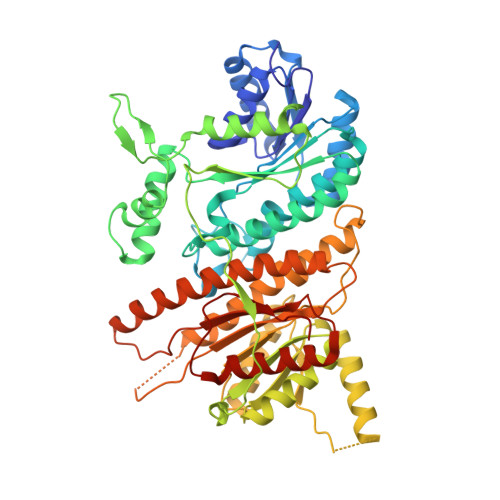Dynamic lid domain of Chloroflexus aurantiacus Malonyl-CoA reductase controls the reaction.
Kabasakal, B.V., Cotton, C.A.R., Murray, J.W.(2023) Biochimie 219: 12-20
- PubMed: 37952891
- DOI: https://doi.org/10.1016/j.biochi.2023.11.003
- Primary Citation of Related Structures:
8A30, 8A7S, 8A8T, 8AEO, 8AEQ, 8AER, 8AET, 8AEW - PubMed Abstract:
Malonyl-Coenzyme A Reductase (MCR) in Chloroflexus aurantiacus, a characteristic enzyme of the 3-hydroxypropionate (3-HP) cycle, catalyses the reduction of malonyl-CoA to 3-HP. MCR is a bi-functional enzyme; in the first step, malonyl-CoA is reduced to the free intermediate malonate semialdehyde by the C-terminal region of MCR, and this is further reduced to 3-HP by the N-terminal region of MCR. Here we present the crystal structures of both N-terminal and C-terminal regions of the MCR from C. aurantiacus. A catalytic mechanism is suggested by ligand and substrate bound structures, and structural and kinetic studies of MCR variants. Both MCR structures reveal one catalytic, and one non-catalytic SDR (short chain dehydrogenase/reductase) domain. C-terminal MCR has a lid domain which undergoes a conformational change and controls the reaction. In the proposed mechanism of the C-terminal MCR, the conversion of malonyl-CoA to malonate semialdehyde is based on the reduction of malonyl-CoA by NADPH, followed by the decomposition of the hemithioacetal to produce malonate semialdehyde and coenzyme A. Conserved arginines, Arg734 and Arg773 are proposed to play key roles in the mechanism and conserved Ser719, and Tyr737 are other essential residues forming an oxyanion hole for the substrate intermediates.
- Department of Life Sciences, Imperial College, Exhibition Road, London, SW7 2AZ, UK; Turkish Accelerator and Radiation Laboratory, Gölbaşı, 06830, Ankara, Turkiye.
Organizational Affiliation:
















